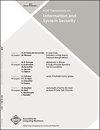网络延迟泄漏了多少匿名性?
Q Engineering
ACM Transactions on Information and System Security
Pub Date : 2010-02-01
DOI:10.1145/1315245.1315257
引用次数: 94
摘要
低延迟匿名系统,如Tor, AN。ON、crowd和Anonymizer.com旨在提供匿名连接,这些连接既无法被只控制几台机器的“本地”对手追踪,又具有足够低的延迟,以支持匿名使用网络服务,如网页浏览和远程登录。这些目标的一个后果是,这些服务会泄漏有关发送方与系统中一个或多个节点之间的网络延迟的一些信息。本文报告了三个实验,这些实验部分地测量了这种泄漏可能损害匿名性的程度。首先,使用2000台互联网主机之间的双向往返时间(RTT)的公共数据集,我们估计,平均而言,知道主机a的网络位置和主机B的RTT泄露了关于B的网络位置的3.64位信息。其次,我们描述了一种攻击,允许一对串通的网站根据本地时间信息和没有额外资源来预测,来自同一Tor出口节点的两个连接是否使用相同的电路,错误率为17%。最后,我们描述了一种攻击,允许恶意网站访问网络坐标系统和一个损坏的Tor路由器,每小时恢复大约6.8位的网络位置。本文章由计算机程序翻译,如有差异,请以英文原文为准。
How much anonymity does network latency leak?
Low-latency anonymity systems such as Tor, AN.ON, Crowds, and Anonymizer.com aim to provide anonymous connections that are both untraceable by "local" adversaries who control only a few machines, and have low enough delay to support anonymous use of network services like web browsing and remote login. One consequence of these goals is that these services leak some information about the network latency between the sender and one or more nodes in the system. This paper reports on three experiments that partially measure the extent to which such leakage can compromise anonymity. First, using a public dataset of pairwise round-trip times (RTTs) between 2000 Internet hosts, we estimate that on average, knowing the network location of host A and the RTT to host B leaks 3.64 bits of information about the network location of B. Second, we describe an attack that allows a pair of colluding web sites to predict, based on local timing information and with no additional resources, whether two connections from the same Tor exit node are using the same circuit with 17% equal error rate. Finally, we describe an attack that allows a malicious website, with access to a network coordinate system and one corrupted Tor router, to recover roughly 6.8 bits of network location per hour.
求助全文
通过发布文献求助,成功后即可免费获取论文全文。
去求助
来源期刊

ACM Transactions on Information and System Security
工程技术-计算机:信息系统
CiteScore
4.50
自引率
0.00%
发文量
0
审稿时长
3.3 months
期刊介绍:
ISSEC is a scholarly, scientific journal that publishes original research papers in all areas of information and system security, including technologies, systems, applications, and policies.
 求助内容:
求助内容: 应助结果提醒方式:
应助结果提醒方式:


